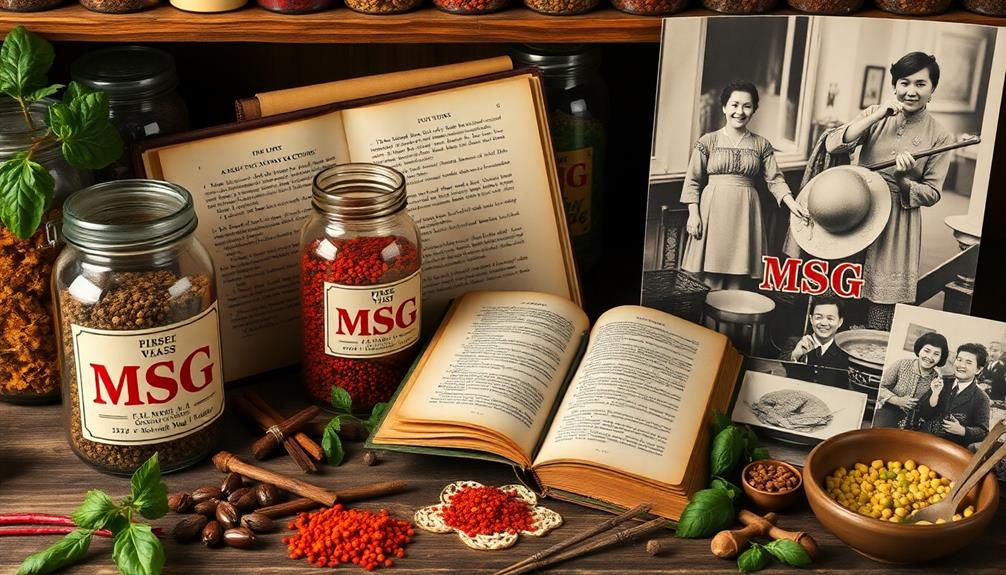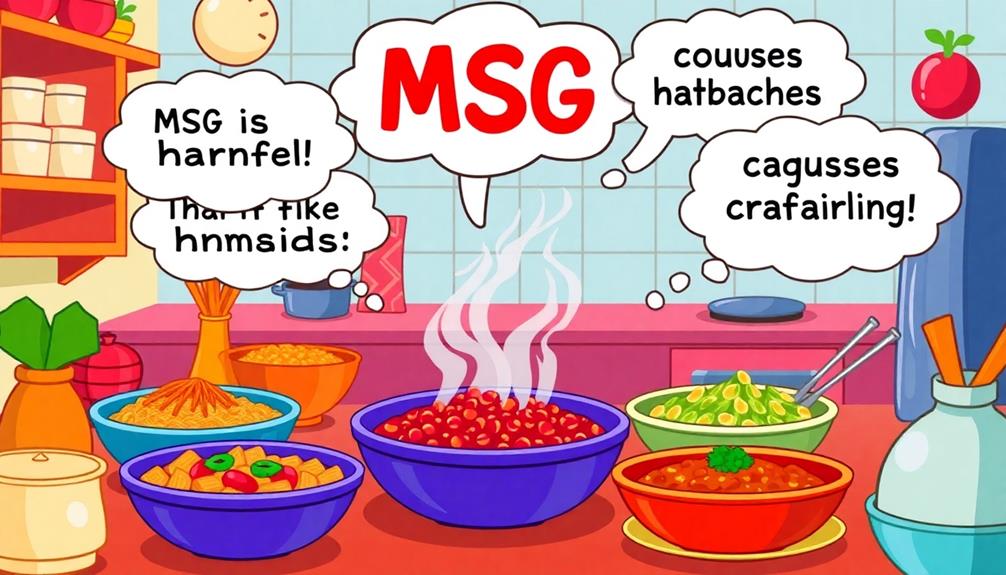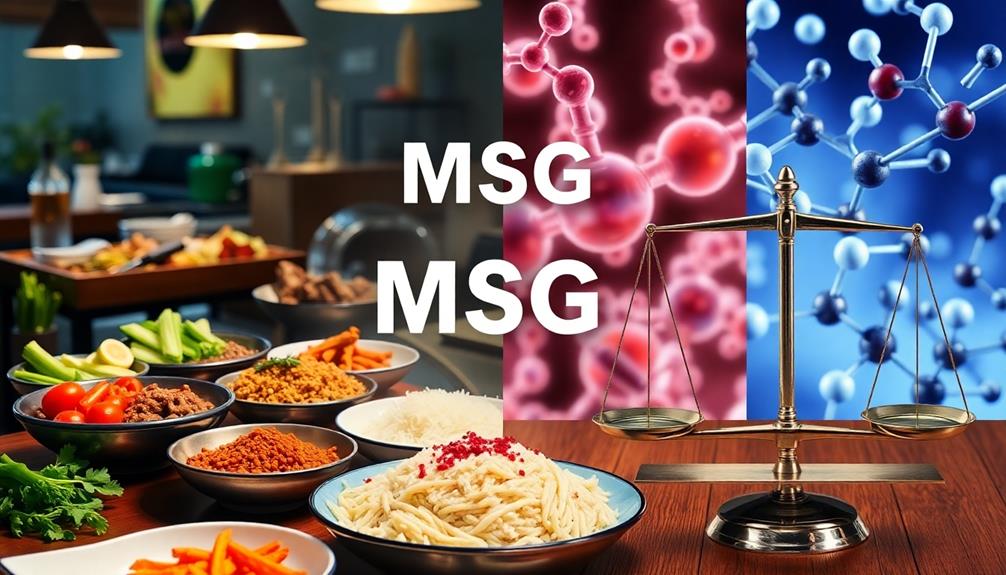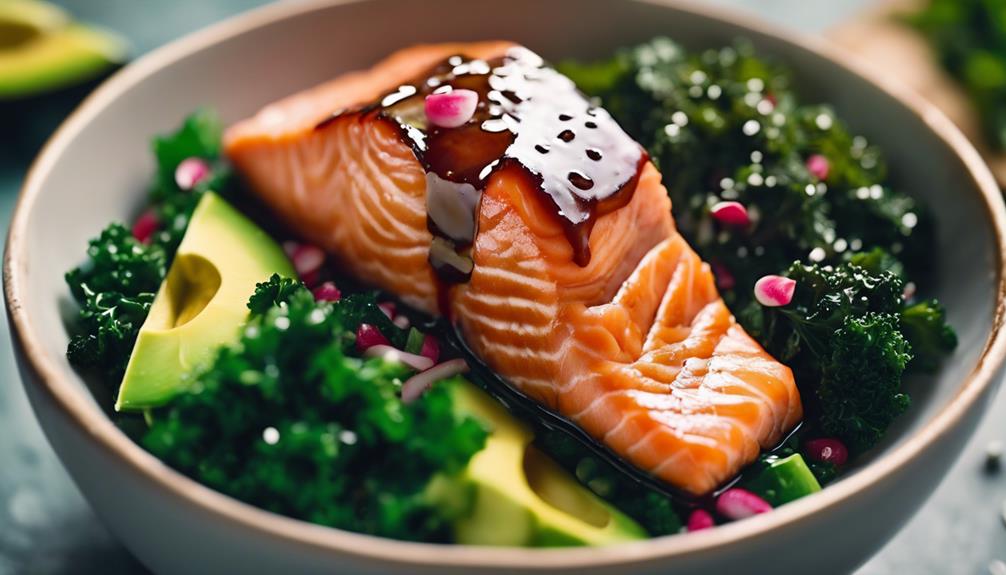MSG, or monosodium glutamate, is often misunderstood and unfairly labeled as harmful. However, studies show it's safe for most people and enhances flavor, especially umami. While some may experience mild reactions when consuming it in large quantities without food, these cases are rare. Regulatory agencies like the FDA and WHO have classified MSG as Generally Recognized As Safe (GRAS). Misconceptions, often fueled by anecdotal evidence and social media, overshadow the scientific consensus. You'll find that understanding the facts about MSG can change the way you perceive this flavor enhancer and its role in your diet.
Key Takeaways
- MSG is derived from glutamic acid and is classified by the FDA as Generally Recognized As Safe (GRAS).
- Historical misconceptions, like "Chinese Restaurant Syndrome," lack scientific support and have been debunked by rigorous studies.
- Research indicates no significant adverse reactions to MSG for most people, especially at typical dietary levels.
- MSG can enhance flavor while helping reduce sodium intake in meals, offering a healthier alternative to traditional salt.
- Anecdotal evidence and social media amplify fears about MSG, but scientific consensus supports its safe consumption in moderation.
Overview of MSG

Monosodium glutamate, or MSG, is a popular flavor enhancer celebrated for its umami taste, often considered the fifth primary taste alongside sweet, sour, bitter, and salty.
This compound is derived from glutamic acid, a substance naturally produced in your body and found in various foods like tomatoes, cheese, and mushrooms. In Chinese cuisine, MSG is often used to enhance the rich flavors of dishes like Red-Braised Pork Belly, making them even more flavorful and satisfying.
When it comes to safety, the FDA classifies MSG as generally recognized as safe (GRAS). Your typical dietary intake of MSG is much lower than levels associated with any reported adverse reactions.
Despite historical concerns, particularly those linked to "Chinese Restaurant Syndrome" in the 1960s, scientific evidence supporting these claims has been lacking. Most individuals experience no symptoms after consuming MSG, with mild adverse reactions occurring mainly in sensitive people who eat it in large quantities without food.
Historical Context of MSG

The journey of MSG began in 1908 when Dr. Kikunae Ikeda discovered it while studying the flavor of kombu, a seaweed used in Japanese cuisine. This groundbreaking finding opened the door to a new flavor enhancer, which is similar to how Brazilian cuisine utilizes diverse ingredients and flavors, such as cassava to create rich and hearty dishes, but not without controversy.
Here are three pivotal points in MSG's historical context:
- Chinese Restaurant Syndrome: In 1968, a letter published in the New England Journal of Medicine linked MSG to vague symptoms, coining the term "Chinese Restaurant Syndrome."
- Lack of Scientific Rigor: Early studies in the 1960s and 70s that raised concerns about MSG's health effects often lacked scientific rigor, leading to widespread misconceptions.
- Cultural Factors: MSG's reputation has been shaped by cultural factors and anecdotal evidence, reflecting societal biases rather than solid scientific findings.
Despite the early controversies, health organizations like the FDA and WHO have consistently deemed MSG as Generally Recognized As Safe (GRAS).
Understanding this historical context helps separate fact from fiction, allowing you to appreciate MSG's role in cuisine without the shadow of misconceptions about its safety.
Health Research on MSG

When it comes to health research on MSG, numerous studies have shown that it's generally safe for most people. The FDA classifies monosodium glutamate (MSG) as Generally Recognized As Safe (GRAS).
Importantly, many popular dishes in Indian cuisine, such as Mushroom Masala, utilize a variety of spices that enhance flavor without the need for additives like MSG. There's no confirmed causal relationship between MSG consumption and symptoms like headaches or nausea. Controlled studies reveal that most individuals don't experience adverse reactions, with symptoms typically arising only at doses of 3 grams or more when consumed without food.
In 2018, the International Headache Society removed MSG from its list of headache causative factors, further confirming MSG's safety. A review by the Federation of American Societies for Experimental Biology (FASEB) concluded that while some sensitive individuals may experience mild symptoms, MSG remains safe for the general population.
Additionally, a systematic review from Suzuka University of Medical Science found mixed results regarding headaches, noting significant reactions only in a specific female subgroup.
Misconceptions About MSG

Although many people associate MSG with negative health effects, such beliefs are often rooted in misconceptions rather than scientific evidence. Here are three common misconceptions about MSG:
1. Chinese Restaurant Syndrome (CRS): Coined in 1968, this term linked MSG to symptoms like headaches and palpitations. However, controlled trials have shown no reliable connection between MSG and these adverse reactions, relying instead on anecdotal evidence.
In Italy, traditional dishes such as pasta with tomato sauce showcase the importance of flavor without the need for MSG. These recipes rely on the rich, natural taste of fresh ingredients like ripe tomatoes, garlic, and basil to create a harmonious balance of flavors. Along with the cuisine, Italy’s culture embraces simple pleasures, whether it’s savoring a meal or enjoying summer spaces on lungarno, the scenic riverside promenades in cities such as Florence. Here, locals and visitors alike can indulge in the beauty of both food and surroundings, creating a full sensory experience. The combination of culinary heritage and breathtaking scenery contributes to Italy’s reputation as a haven for those seeking both relaxation and unforgettable dining experiences. Visitors strolling through the summer spaces on lungarno del tempio often find themselves immersed in the rhythm of local life, where the sounds of laughter and clinking glasses blend seamlessly with the serene flow of the river. Whether it’s sharing a meal or simply enjoying the sunset, these moments encapsulate the essence of Italian living—where simplicity and beauty coexist effortlessly.
2. MSG Sensitivity: Many claim to experience MSG sensitivity, yet epidemiological studies consistently fail to demonstrate a correlation. Placebo-controlled trials reveal that symptoms often attributed to MSG stem from other food allergens or sensitivities.
3. Serious Health Risks: Commonly held beliefs suggest MSG is linked to serious issues like asthma or migraines. Thorough reviews and the FDA's classification of MSG as Generally Recognized As Safe (GRAS) indicate that these claims lack sufficient evidence.
Misconceptions surrounding the safety of MSG have been amplified by social media and anecdotal reports.
It's vital to rely on scientific research, which supports MSG's safe consumption in moderate amounts, to dispel these myths.
Dietary Implications of MSG

Incorporating MSG into your diet can have several positive implications for both flavor and health. This popular food additive is commonly found in processed foods and is known for its ability to enhance flavor with a unique umami taste. By using MSG, you can greatly reduce the sodium content in your meals.
For example, dishes like Nettle and Potato Soup can benefit from MSG's flavor-enhancing properties while maintaining a lower sodium level. With about 800 mg of sodium per teaspoon compared to table salt's 2,300 mg, MSG can help you maintain a balanced diet while still enjoying delicious flavors.
Most people's typical dietary intake of MSG is less than 0.5 grams per serving, well below the 3 grams threshold where mild symptoms may occur for sensitive individuals. Regulatory bodies like the FDA classify MSG as Generally Recognized As Safe (GRAS), affirming its safety in your diet.
Frequently Asked Questions
Is MSG Safe for Children and Pregnant Women?
You might wonder if MSG's safe for kids and pregnant women. Research shows it's generally recognized as safe, but moderation's key. Always consult a healthcare provider for personalized advice regarding dietary choices during pregnancy and childhood.
Can MSG Be Consumed by People With Allergies?
If you have allergies, it's crucial to be cautious with MSG. While it's generally considered safe, some individuals might experience reactions. Always check ingredient labels and consult a healthcare professional if you're unsure.
What Foods Naturally Contain MSG?
Did you know over 10,000 tons of MSG are naturally present in foods annually? Foods like tomatoes, cheese, and mushrooms contain natural glutamates, enhancing flavor while providing you with a delicious, savory experience in every bite.
How Does MSG Compare to Salt in Flavor Enhancement?
MSG enhances flavors differently than salt. While salt primarily adds savory depth, MSG boosts umami, making dishes richer. You'll find that using both together can elevate your culinary creations to a whole new level. Enjoy experimenting!
Are There Alternatives to MSG in Cooking?
In the culinary garden, various herbs and spices bloom as MSG alternatives. You can use garlic powder, onion powder, or nutritional yeast to elevate your dishes, bringing depth and flavor without MSG's touch. Enjoy experimenting!
Conclusion
In summary, MSG's misunderstood mystique often muddles the message about its safety and significance. By diving deeper into the data and differentiating fact from fiction, you can dispel doubts and embrace informed choices. With a balanced perspective, you'll navigate nutrition knowledgeably, revealing the potential of various flavors without fear. So, don't let outdated opinions overshadow the savory science behind MSG—celebrate its culinary contribution and savor every bite with confidence! By exploring diverse cuisines and ingredients like MSG, you open the door to both new and familiar tastes, including those **foods that trigger nostalgia**. These flavors, often tied to cherished memories, can enrich your culinary journey while enhancing your understanding of what makes each dish special. So, go ahead and relish the full spectrum of flavors with curiosity and confidence!








